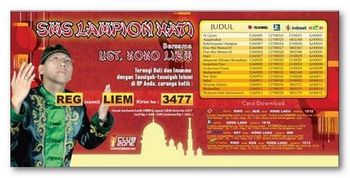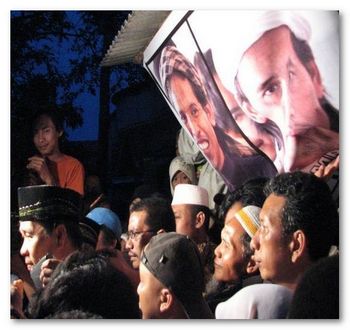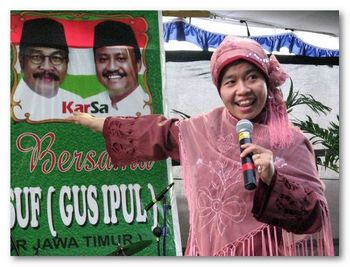Chinese Muslim preachers are popular, but they don’t always promote greater pluralism
Hew Wai-Weng
Tan Mei Hwa’s preaching style is especially popular among women
Hew Wai-Weng |
In today’s Indonesia, Chinese Muslim preachers have a surprisingly high profile. Although the figures are highly contested, it is generally believed that only about 1 to 2 percent of Chinese Indonesians, out of a total population of 5 to 6 million, are Muslims. Yet Chinese Muslim preachers are popular, not only among Chinese converts, but also with non-Chinese Muslim Indonesians. They appear regularly on religious television programs and hold public talks that are often attended by large crowds.
Successful preachers in contemporary Indonesia are also media celebrities, skilled at tailoring their messages to a media audience. Chinese preachers appear to have a special marketing pull, because of their ethnicity and their status as converts. Most Indonesians are born into the Muslim faith, so converts arouse curiosity under any circumstances, but especially when they are Chinese. Many Muslims are concerned with what they see as a process of ‘Christianisation’ in Indonesia, and so they view the conversion of Chinese Indonesians – a community that is almost forty per cent Christian – as a welcome phenomenon. At the same time, many Muslims think that the spiritual journey toward piety that these converts-turned-preachers make provides a positive role model for non-practising Muslims. The preaching of Chinese Muslims takes varying forms and they each have different messages, reflecting their varying socio-economic backgrounds, cultural outlooks, conversion experiences and religious education. It might be said that Chinese preachers are as diverse as Indonesian Islam itself.
Tan Mei Hwa: singing, dancing, preaching
Tan Mei Hwa, or Ida Astuti, is both a preacher and a performer. Her Chinese identity and entertaining preaching style have made her one of the most popular preachers in East Java. She has speaking engagements nearly every day, and during Ramadhan she hosted a religious program on the biggest local television station in East Java, JTV. She is known as Bu Nyai – Tan Mei Hwa, ‘nyai’ being a prestigious title for a female religious scholar in the Javanese tradition. Always dressed in fashionable and colourful Muslim attire, her easily digested religious messages and down-to-earth preaching style is welcomed by many ordinary Muslims, especially women and girls. She intersperses her message with singing, plenty of jokes and sometimes even dancing. With her expressive body language she can hold her audience’s attention for a full hour and a half of preaching.
She uses her Chinese name, Tan Mei Hwa, in order to differentiate herself from other preachers who have Islamic or Indonesian names. When she preaches, she always tries to present a positive image of Chinese Indonesians to the Muslim crowd by saying that not all Chinese are rich or exclusive. She likes to highlight the role of Cheng Ho, or Zheng He, a 15th century Muslim admiral from China, who helped promote early Islamisation in Java. She also emphasises that some of the revered wali songo, the nine saints who are mythologised as the first persons to spread Islam in Java, were of Chinese descent.
Chinese preachers appear to have a special marketing pull, because of their ethnicity and their status as converts
In a public talk I witnessed in Surabaya during Ramadhan in 2008, Tan Mei Hwa urged the crowd, who were mostly non-Chinese Muslims, to acknowledge and respect difference. She recounted a short conversation between two Muslim girls in which one had refused to go to a pengajian (Islamic study session) because it was being led by a Chinese preacher. She then cited Qur’anic texts and told her audience, ‘I was born as Tan Mei Hua. Can I choose to not be Chinese? Is it a sin to be Chinese? There is no Qur’anic text that obliges someone to be ethnic Chinese or not. God creates us in different shapes and colours. We are all brother and sisters, and we should respect each other.’ Besides promoting tolerance within the Muslim community, Tan Mei Hwa’s chief message concerns the universality of Islamic values and the application of Islamic teachings in everyday life.
Koko Liem: Chinese package, Islamic message
Born Liem Hai Thai, Koko Liem adopted a Muslim name, Muhammad Utsman Anshori, when he converted to Islam. This is something many converts do. However, he prefers to be called Koko Liem when he preaches, because, he says, it is more ‘down-to-earth’. It also differentiates him from other preachers. Koko means ‘brother’ in the Hokkien dialect, while Liem is a clan name that is very common among Indonesians of Chinese descent. It’s a name that marks him as indisputably Chinese.
Besides his name, Koko Liem’s other preaching trademark is that he wears traditional Chinese clothing when he preaches. He says he wears this outfit because it looks interesting and it’s different from what other preachers wear. He adds that it is a preaching strategy to show that Islamic teaching is not incompatible with Chinese custom. His Chinese name and clothing are a strategic way of packaging and marketing his message and do not reflect his daily cultural practice. He can only speak a small amount of Hokkien dialect, but speaks fluent Arabic and Indonesian, and is married to a Javanese woman.
 |
Koko Liem’s latest religious SMS servicewww.kokoliem.com |
Koko Liem was one of the finalists on Mimbar Dai, a reality show on TPI (Indonesian Education Television) in which one of the competitors is awarded the title of ‘best preacher’. He is one of the most creative Chinese preachers, whose Islamic business career goes beyond public preaching to include acting and advertising, umroh and haj travel, a religious SMS service, and the establishment of a religious school for new converts. He has a personal website (www.kokoliem.com) featuring reports and video clips of his public preaching engagements, as well as Islamic articles, consulting services and stories of new converts. He has also affiliated himself with the UJE Centre, owned by a popular celebrity-preacher, Jefri al-Buchori (Uje). He holds monthly Islamic study sessions for new converts and occasionally speaks at the popular ‘I like Monday’ Islamic study sessions at the UJE Centre.
In his latest SMS religious service, Lampion Hati (A Lantern for the Heart), which offers Islamic-based advice, teaching and ring tones to subscribers, Koko Liem strategically combines Chinese cultural symbols with Islamic messages to attract customers. Against a red background decorated with pictures of Chinese lanterns and the silhouette of a mosque, Koko Liem features in a posture of prayer, wearing green (the colour of Islam) traditional Chinese clothing. The advertisement for his SMS service declares his goal to be ‘illuminating your heart and faith with Islamic advice’. This combination of Chinese cultural symbols and Islamic messages gives Koko Liem his uniqueness and makes him especially popular among Muslim Indonesians.
Irena Handono: from church activist to Islamic preacher
Irena Handono, or Han Hoo Lie, a former student at Atmajaya Catholic University in Jakarta, was a church activist and nun before she converted to Islam. Unlike Tan Mei Hua and Koko Liem, Irena Handoko does not position herself as a ‘Chinese’ preacher. Although some of her Muslim admirers know about her Chinese identity, her trademark as a preacher is her background as a Catholic nun. She is active in numerous Islamic organisations, most of which are conservatively inclined, including Forum Gerakan Anti Pornografi dan Pornoaksi (FORGAPP, Forum for the Anti Pornography and Porno-action Movement). She can be regarded as a more fundamentalist preacher and is well-known in conservative circles.
Whenever she preaches, Irena emphasises her experience of conversion to Islam. She makes lengthy and detailed theological comparisons between Christianity and Islam which always end up demonstrating Islam’s superiority. According to Irena, Islam is the only true religion recognised by God, and the Christian concept of the ‘trinity’ is false. She criticises non-practising Muslims for not using the Qur’an to guide every aspect of their lives. She also attacks prominent Muslims who have promoted pluralistic ideas, such as the well-known religious scholar Syafii Maarif, who had the temerity to suggest that not only Muslims, but also Christians and Jews would have a place in heaven. Her criticisms are welcomed among conservative-fundamental Islamic groups and her preaching is frequently reported in Islamic magazines and newspapers such as Sabili and Republika. For Irena, religious experience is more fundamental than ethnicity as a guide to daily life and preaching.
Anton Medan: from gangster to preacher
Anton Medan, or Tan Kok Liong, is a controversial character, not because he is Chinese, but because in an earlier life he was a preman, or gangster. Now a popular dakwah figure, his involvement in murder, robbery, and illegal gambling led him to spend 18 years of his life in prison. After converting to Islam, he started his preaching career amongst prisoners and prostitutes, before becoming popular with a wider public and on television. His personal transformation from immoral hoodlum to pious preacher is his preaching trademark.
 |
Anton Medan (at the front of the crowd, wearing a black peci cap)visited Amrozi’s family in Lamongan, before Amrozi was executed forterrorismHew Wai-Weng |
He has also established an Islamic boarding school in Bogor that promotes entrepreneurship alongside religious education and where Chinese language and business skills are compulsory subjects. In the same compound, there is a Chinese-style mosque, Masjid Tan Kok Liong, which resembles the architectural design of a traditional Chinese palace. Anton Medan says this building is part of an effort to preach Islam to Chinese Indonesians, and to promote pembauran (blending) between Chinese and non-Chinese Indonesians. He does not see a contradiction between being a Muslim and Chinese, and claims that he has the strength of both, or as he puts it, ‘Akal Cina, Hati Muslim’; ‘Chinese mind’, by which he means a business orientation, and ‘Muslim heart’, denoting an emphasis on spirituality and morality.
The media has sometimes highlighted Anton Medan’s conservative side. For example, his visits to the families of convicted Bali bombers Amrozi and Samudra before the two men were executed for terrorism, was widely reported in the national press. As a new convert with a criminal background, his assertion of his Islamic identity appeals to a broader Muslim audience.
From taboo to commodity
During the long years of Suharto’s New Order regime, Chinese culture was taboo. The government even banned the Mandarin translation of the Qur’an. However, in contemporary democratic Indonesia, Chinese culture has become a marketable commodity, not only consumed by the ethnic Chinese themselves, but also by non-Chinese Indonesians. For example, about eighty percent of the members of lion dance groups in Surabaya are either Javanese or Madurese, and Taiwanese popular culture (such as F4’s Meteor Garden) is popular among non-Chinese youth. The popularity of Chinese preachers amongst non-Chinese Muslims is a further illustration of this appeal.
The new celebrity status of Chinese preachers may help to improve the image of Chinese Indonesians among the broader Indonesian population. Chinese Indonesians are often accused of being ‘exclusive’, of holding themselves apart from the broader population, and of refusing to mix. These feelings have traditionally been strongest in devout Muslim circles, and in Muslim organisations – right back to the early years of the twentieth century when Indonesia’s first truly mass organisation, Sarekat Islam (Islamic Union), was set up to campaign against the influence of Chinese businesses. Now, not only moderate Muslim organisations (such as Nadhlatul Ulama and Muhammadiyah), but also conservative groups (like the Islamic Defenders’ Front, FPI, and the Prosperous Justice Party, PKS) are enthusiastic about recruiting Chinese Muslims, both as members and leaders. They do so to prove that they practise multiculturalism, and also to hold up Chinese converts as models of devout behaviour to non-practising Muslims.
Chinese Muslim preachers may diversify the appearance of preaching but they do not necessarily add greater pluralism to the substance of religious belief and practice
However it would be too simplistic to suggest that the consumption of Chinese culture by non-Chinese Muslims can lead to the erosion of ethnic boundaries and suspicions. On the contrary, some Chinese Muslim preachers strategically use stereotypes and symbols of Chinese culture (for example, Koko Liem’s traditional Chinese attire) to attract audiences and promote the universality of Islam. This stereotypical representation of Chinese Indonesians implies that Chinese culture is always attached to the ethnic Chinese, no matter how far they go to adapt to the Muslim mainstream, and that the distinction between ‘Chinese’ and ‘indigenous’ Indonesians is something that can never be erased.
Neither does preaching by Chinese Muslims necessarily contribute to a more progressive understanding of Islam. Chinese Muslim preachers may diversify the appearance of preaching – simply because they look Chinese – but they do not necessarily add greater pluralism to the substance of religious belief and practice.
In fact, most Chinese Muslim preachers are conservative on religious and social matters. Irena Handono is the extreme case: her constant criticism of Christianity in her preaching not only alarms non-Muslims, it also alienates her from moderate Muslim audiences. Most Chinese Muslim preachers avoid controversial issues, and focus on how best to apply Islamic values in daily life. They tend to be moderate and tolerant in their preaching, yet restrict themselves to certain orthodox interpretations of Islamic teaching. Tan Mei Hwa, for instance, once told her audiences that ‘women are not suited to become Muslim leaders’. For converts, subscription to a conservative understanding of Islam is not surprising, as this is one way to prove the sincerity of one’s conversion, and demonstrate one’s credentials as a preacher.
The popularity of Chinese Muslim preachers reflects the commodification of both Chineseness and Islam in contemporary Indonesia. Diversity of styles is not always accompanied by plurality of discourses. Thus, while the appearance of a Chinese preacher in traditional Chinese costume on a religious television program may help to promote a positive image of ethnic Chinese among non-Chinese audiences and diversify the face of Islamic preaching, it does not necessarily break down ethnic stereotypes and pluralise the substance of religion.
Hew Wai-Weng (waiweng.hew@anu.edu.au) is a PhD student in the Department of Political and Social Change, Australian National University.












